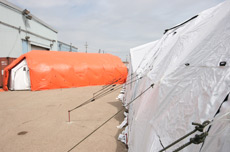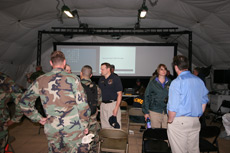PHOTO ALBUM
 During the week of April 27, 2009, New York City’s Office of the Chief Medical Examiner (OCME) took part in a joint training event alongside members of the Air National Guard Fatality Search and Recovery Team (FSRT). The training was designed to help civilian and military agencies learn to integrate forces to better respond to large-scale emergencies involving mass fatalities.
During the week of April 27, 2009, New York City’s Office of the Chief Medical Examiner (OCME) took part in a joint training event alongside members of the Air National Guard Fatality Search and Recovery Team (FSRT). The training was designed to help civilian and military agencies learn to integrate forces to better respond to large-scale emergencies involving mass fatalities.
OCME and military personnel were given the task of responding to a simulated bus explosion in New York City. In a similar real-life scenario the OCME would be in charge of fatality management operations, from performing site reconnaissance to searching for and extracting fatalities to performing autopsies and decontamination to prevent the spread of any possible radioactive materials.
After first evaluating the scene, the OCME would call for support from the FSRT in recovering victims from the scene if needed.
Personnel performed operations in several Reeves Shelter Systems purchased by the OCME in 2007, including a Decedent Decontamination/Isolation Collection Point (DD/ICP) Negative Pressure Isolation-Autopsy Suite and a 249 square foot DRASH Command and Control Center.
Reeves manufacturer DHS Systems LLC also provided a DRASH J Shelter to serve as a staging and training center.
With civilian and military forces working together side by side, communication was essential throughout the training. Inside the Command and Control Center, which housed computers and camera equipment, staff collected and deciphered information gathered at the site of the fictitious explosion.
 Briefings were held inside the 1,250 square foot J shelter to update responders working at the site’s various stations. A DRASH Deployable Command and Control Equipment (DC2E) J Series Large Screen Display allowed workers to view multiple images from the scene, as well as information from commanders’ computers, simultaneously.
Briefings were held inside the 1,250 square foot J shelter to update responders working at the site’s various stations. A DRASH Deployable Command and Control Equipment (DC2E) J Series Large Screen Display allowed workers to view multiple images from the scene, as well as information from commanders’ computers, simultaneously.
“In a situation like this communication is critical. It’s key that people know what they need to do, and having a central command center allows people to stay informed and complete their assignment at the scene,” said Major Tim Bonk, Services Staff Officer of the J3 Operations Cell of the New York National Guard Joint Operations Center, who attended the training.
OCME personnel utilized the 100 foot long Decedent Decontamination/Isolation Collection Point (DD/ICP) to handle fatalities once collected from the scene. The system features areas for triage, evidence processing, forensic exams, decontamination and dental identification.
Nearby, the Isolation System acted as an autopsy suite for contaminated victims. A HEPA filtration system provided negative pressure to prevent hazardous materials from spreading to the surrounding environment.
Faced with the challenge of safely and thoroughly investigating a potentially hazardous incident scene while properly identifying and handling casualties, the Reeves Shelter Systems proved essential to responders completing their mission.
“When we purchased the Reeves Shelter Systems, we knew we needed shelters that could support long-term operations that can last days, weeks, months and even years,” explains Frank DePaolo, director of the OCME’s Special Operations Division. “These shelters are the most robust, sturdy systems out there and let us complete what we need to do.”